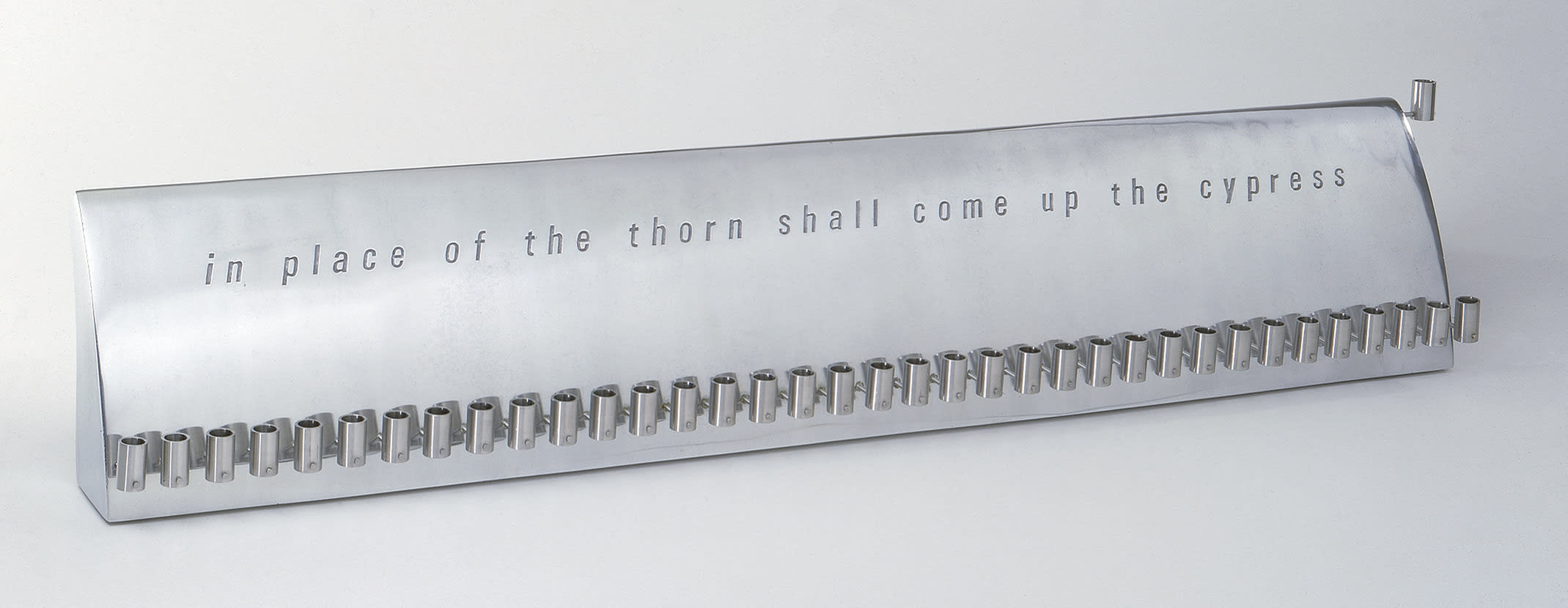
- Object Name:
- Hanukkah Lamp
- Artist/Maker:
- Harley Swedler
- Bio:
- American, b. Canada, 1962
- Title:
- Derivation 36/8
- Place Made:
- New York, United States
- Date:
- 1992
- Medium:
- Cast aluminum and stainless steel
- Dimensions:
- 3 × 7 × 36 in. (7.6 × 17.8 × 91.4 cm)
- Credit Line:
- Purchase: Judaica Acquisitions Fund and Gift of Floyd Lattin
- Accession Number:
- 1994-75
Not On View
Born in Ottawa, Ontario, in 1962, Harley Swedler studied architecture at Carleton University in Ottawa and in Rome, and metalsmithing at Parsons School of Design, in New York City. Swedler's artistic and architectural training, fascination with Jewish ritual, and sense of inventiveness enable him to create concepts that serve ritual traditions in refreshing and unusual ways. He views Jewish ritual with a sense of awe and mystery, writing, "The rituals of Judaism are a bridge, potentially mending the rift, which distinguishes man from a divine source. I interpret these objects as a powerful expression of the collective longing for reunion, redemption, and comprehension".
Among the museum's contemporary Judaica holdings are two works by Swedler, Derivation 36/8 and priva/See. They demonstrate Swedler's thoughtful and imaginative approaches to ceremonial objects and illustrate the surprising variation possible among Hanukkah lamps. Derivation 36/8 the artist created a broad, stainless-steel, wedgelike form, on which he mounted thirty-six candle receptacles. The arrangement supplies the total number of holders needed for all of the candles lit on Hanukkah. One uses a different set of candleholders each night, beginning from the right. The resulting movement across the front of the lamp during the eight nights reminds one of the passage of time. The only embellishment of this sleek shape is an inscription along the lamp's face that refers to a traditional Hanukkah song "Ma'oz Tzur" (0 Fortress, Rock of My Salvation). The song makes a typological reference to the holiday by recalling other victory stories about the Jews. One line refers to the story of the triumph of Mordecai and Esther over the evil Haman from the Book of Esther. The lyrics allude to Haman as a spiteful thorn, while likening Mordecai to a stately cypress. Swedler chose the words of Isaiah 55:13, "In place of the thorn shall come up the cypress," to capture the meaning of this popular song.
Among the museum's contemporary Judaica holdings are two works by Swedler, Derivation 36/8 and priva/See. They demonstrate Swedler's thoughtful and imaginative approaches to ceremonial objects and illustrate the surprising variation possible among Hanukkah lamps. Derivation 36/8 the artist created a broad, stainless-steel, wedgelike form, on which he mounted thirty-six candle receptacles. The arrangement supplies the total number of holders needed for all of the candles lit on Hanukkah. One uses a different set of candleholders each night, beginning from the right. The resulting movement across the front of the lamp during the eight nights reminds one of the passage of time. The only embellishment of this sleek shape is an inscription along the lamp's face that refers to a traditional Hanukkah song "Ma'oz Tzur" (0 Fortress, Rock of My Salvation). The song makes a typological reference to the holiday by recalling other victory stories about the Jews. One line refers to the story of the triumph of Mordecai and Esther over the evil Haman from the Book of Esther. The lyrics allude to Haman as a spiteful thorn, while likening Mordecai to a stately cypress. Swedler chose the words of Isaiah 55:13, "In place of the thorn shall come up the cypress," to capture the meaning of this popular song.
Information may change as a result of ongoing research.